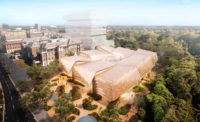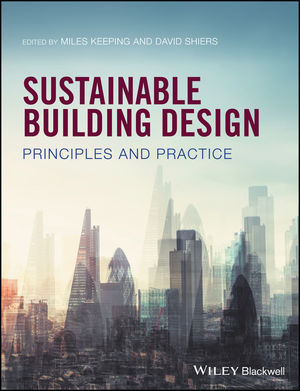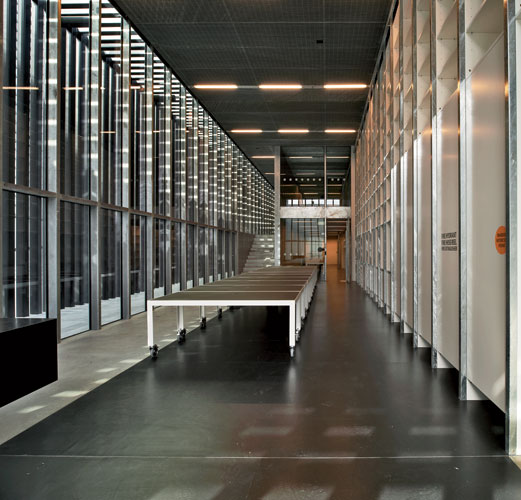RMIT Design Hub
When A Square Building Flips Out: With more than 16,000 rotating glass discs, a center for multidisciplinary design gives a new spin to engaging with its surroundings.






















Architects & Firms
Melbourne, Australia
Sean Godsell is a surprise. I'm expecting a rising rock star of an architect, a Melbourne Bjarke Ingels, with more success than he knows how to use. The man I find is almost the opposite'more in the mold of Glenn Murcutt, with a small, dedicated practice, an intense seriousness about the job, and a staunch devotion to making architecture from first principles.
Godsell's reputation, like Murcutt's, is bigger than his buildings, which are themselves remarkably Murcuttesque, with their orthogonal forms, underdressed materials, and attenuated plans. Mostly boxes, they range from Future Shack, the 1995 parasol-sheltered habitable shipping container that first put Godsell on the international stage, through a series of widely published steel-and-timber houses. They stand in contradistinction to the typical Melbourne shtick, which implies that architecture is a bit of a giggle and repeatedly reenacts Venturi with the multicolored, the stuck-on, the decorative. Godsell is undisturbed by this, saying, 'I'm happy to work in isolation.'
Why the box? All architects fear being boring, says Godsell. The box is just the hardest form to make interesting. What is no surprise is that Godsell's latest triumph, the Royal Melbourne Institute of Technology (RMIT) Design Hub, is yet another box (or rather two), writ tall.
Highly nuanced and spatially serene, this project works on several levels and scales. From a distance, at the clash of two street grids that marks one of Melbourne's messiest and least charming precincts, it reads as an exercise in cool self-possession: translucent, ordered, its glowing skin folded with loose precision, kimono-like, about a solid core.
Closer up, you notice that the skin on one box has nearly 16,250 sandblasted-glass discs, which can be used for applied solar research and one day may fuel the building. (For more on the façade, go to the Dynamic Facades CEU story.) Get even closer and you see that the discs become more opaque, their tessellation more dominant. The discs rotate (vertically on three walls, horizontally on the other) to reduce solar gain; when they do, the building becomes more textural, acquiring a reptilian scaliness.
Australian universities can be divided into those established long ago on their own sprawling campuses and Johnny-come-lately institutions that are more scattered but also more urban. The latter stand at the forefront of current commitments to urban reinvestment and community connectivity, a vogue on which RMIT wholeheartedly capitalizes.
Margaret Gardner, RMIT's vice chancellor and the primary client for the Design Hub, says she wanted a building that would unify the design disciplines across this most urban of campuses, providing flexible studio spaces (or 'warehouses') for transdisciplinary postgraduate research teams while drawing the life of the city in and through it.
It's a nice program and well fulfilled by Godsell's design, with its pair of boxes: an eight-story stack of flexible studio and exhibition spaces, and a two-story archives wing. A broad, caf'-lined pedestrian space ramps between the two buildings, linking the street at one end of the site to a forthcoming commercial development at the other.
Structurally, the tall building is pretty conventional, with steel-clad concrete columns supporting partly-post-tensioned floor slabs from which the facade is hung. The low archives wing offers a visual and structural counterpoint, with a set of rectilinear steel tubes slipped one inside the other.
In the tall box, each main floor has a vast 'warehouse' space for changing, project-based design teams and a parallel 'long room' that serves as circulation, exhibition, and gathering space. On top of the building, four steel-portal pavilions house seminar rooms that open onto a roof deck.
A glance at Godsell's oeuvre suggests a rationalist, Miesian approach. And Mies is certainly there. But less predictable influences can be seen too, in five 'tributes''to Shinohara, Corbusier, Palladio, Michelangelo, and Peter Corrigan.
Corrigan, father of Melbourne's Venturi-ism, taught Godsell and employed him briefly as a student (before the three years Godsell spent, more significantly, working in London with Denys Lasdun). The tribute takes the form of a wall-size supergraphic''MOTHER KNOWS''from a 1981 Corrigan artwork on a Melbourne tram.
The other tributes, being spatial, are more interesting. There's the door-within-a-door at one of the archives' entrances (Michelangelo's San Lorenzo Chapel), the archives' layered box front (Palladio's Il Redentore), the slender off-form columns in the main building's basement workshop and foyer (Corbu's Ahmedabad), and, most enchanting, the long, ruthless Shinohara stair that drops 29 feet in a slot 195 feet long and 6 feet wide that runs through the archives on the ground floor.
But one influence is the most surprising and entrancing of all'John Soane. At first glance, Soane's house in London seems to represent everything that Godsell's boxes preclude: complexity, darkness, symbolism, intrigue, romance. Yet Godsell says, 'There's a lot of Soane in this building.' He's right. The winding route, the choreographed glimpses (one spanning the length of the Shinohara stair), the use of darkness as a ground for light, the way delight is deployed to enrich commodity; pure Soane. If good architecture involves complexity that appears simple, minimalism that feels rich, and pragmatism fleshed out with beauty, then this is it.
Elizabeth Farrelly is a Sydney-based columnist and the author of Glenn Murcutt: Three Houses; Blubberland: The Dangers of Happiness; and Potential Difference.
Completion Date: July 2012
Gross square footage: 140,000 square feet
Total construction cost: Withheld
Architect:
Sean Godsell Architects
PeopleOwner: RMIT University
Architect:
Personnel in architect's firm who should receive special credit:
Architect in Association (of record) Architect of record: Peddle Thorp Architects Interior designer: Sean Godsell Architects
Engineer(s): Lighting: Services: Aecom Pty Ltd Acoustical: Aecom
Other: Quantity Surveyor: Davis Langdon Pty Ltdd Project Manager: Aurecon Pty Ltdd Façade contractor: Permasteelisa Group Pty Ltd Accessibilty consultant: Architecture and Access (Aus.) Pty Ltdd
General contractor: Photographer(s): Earl Carter Photography CAD system, project management, or other software used: AutoCAD, Aconex |
Products
Structural system
Exterior cladding
Metal Panels:
Façade: Off form concrete: Off form concrete, Class 2 finish Moisture barrier: Volclay ‘Voltex’ Curtain wall: See Facade Other cladding unique to this project: 30 x 3 galvanized steel grating: Rhino Grating
External paving:
SW Drains
Roofing
Windows
Glazing
Skylights:
Doors
Fire-control doors, security grilles:
Special doors:
Hardware
Closers:
Exit devices:
Pulls:
Interior finishes
Cabinetwork and custom woodwork:
Paints and stains:
Wall coverings:
Wall cladding:
Floor and wall tile:
Resilient flooring:
Raised flooring:
Special interior finishes unique to this project:
Furnishings
Fixed seating:
Chairs:
Tables:
Lighting
Downlights:
Task lighting: Artemide ‘Tolomeo’ desk reading light Dimming System or other lighting controls: DALI lighting control system
Conveyance
Plumbing
Appliances
Energy Photovoltaic system: The outer skin of the Hub incorporates automated glass sun shading cells that include solar power infrastructure and fresh air intakes that improve the internal air quality and reduce running costs.
Other unique products that contribute to sustainability:
Add any additional building components or special equipment that made a significant contribution to this project: |















